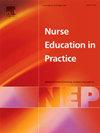The future midwifery workforce: A survey of the education experiences of midwifery students in Australia
IF 3.3
3区 医学
Q1 NURSING
引用次数: 0
Abstract
Aim
To understand students’ views on and experiences of their pre-registration midwifery education in Australia, including continuity of care experiences and clinical practice placements and their preferences for future employment.
Background
Increasing the number of midwifery student enrolments and improving student experience are suggested solutions to shortages in the Australian midwifery workforce.
Design
An anonymous online survey.
Methods
Open to students currently enrolled in an education programme leading to Australian midwifery registration or who had recently completed such a programme but had not yet commenced employment. Quantitative data were analysed through descriptive statistics and chi-squared tests. Frequency counts and inductive content analysis were used to analyse qualitative data. This research was undertaken as part of the national Midwifery Futures project.
Results
A total of 303 eligible responses were received. While most students felt their midwifery education prepared them well for future practice, a third (n = 93/281, 33.1 %) had taken or were considering leave and more than half (n = 161/281, 57.3 %) had considered withdrawing. Continuity of care experiences were highly valued by students as an educational experience. Nearly all students (n = 257/278, 92.4 %) preferred future employment in a clinical midwifery role and most (n = 206/257, 80.2 %) wished to work in midwifery group practice or team midwifery service in a public hospital.
Conclusions
Midwifery students in Australia felt well-prepared by their education programmes to practice midwifery. However, many students also found meeting the requirements of their degree challenging. Further research and efforts are required to support students to complete their midwifery education.
未来的助产士队伍:对澳大利亚助产士学生教育经历的调查
目的了解学生对在澳洲注册前助产学教育的看法和经验,包括护理经验和临床实习的连续性,以及他们对未来就业的偏好。背景:增加助产学学生的入学人数和改善学生的体验是解决澳大利亚助产学劳动力短缺的建议。一个匿名的在线调查。方法本课程面向正在攻读澳大利亚助产学注册课程的学生,或刚刚完成该课程但尚未开始就业的学生。定量资料通过描述性统计和卡方检验进行分析。采用频率计数法和归纳含量分析法对定性数据进行分析。这项研究是作为国家助产未来项目的一部分进行的。结果共收到符合条件的问卷303份。虽然大多数学生认为他们的助产教育为他们未来的实践做好了准备,但三分之一(n = 93/281,33.1% %)已经或正在考虑休假,超过一半(n = 161/281,57.3% %)考虑过退学。作为一种教育经历,学生们高度重视护理经历的连续性。几乎所有的学生( = 257/278,92.4 %)希望将来从事临床助产工作,大多数学生( = 206/257,80.2 %)希望在公立医院从事助产小组实习或助产团队服务。结论澳大利亚助产学专业的学生认为他们的教育项目为助产学实践做好了充分的准备。然而,许多学生也发现达到学位要求具有挑战性。需要进一步的研究和努力来支持学生完成助产学教育。
本文章由计算机程序翻译,如有差异,请以英文原文为准。
求助全文
约1分钟内获得全文
求助全文
来源期刊

Nurse Education in Practice
NURSING-
CiteScore
5.40
自引率
9.40%
发文量
180
审稿时长
51 days
期刊介绍:
Nurse Education in Practice enables lecturers and practitioners to both share and disseminate evidence that demonstrates the actual practice of education as it is experienced in the realities of their respective work environments. It is supportive of new authors and will be at the forefront in publishing individual and collaborative papers that demonstrate the link between education and practice.
 求助内容:
求助内容: 应助结果提醒方式:
应助结果提醒方式:


